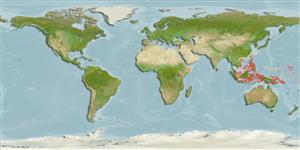>
Gobiiformes (Gobies) >
Gobiidae (Gobies) > Gobiinae
Etymology: Gobiopsis: Latin, gobius = gudgeon + Greek, opsis = appearance (Ref. 45335).
More on author: Herre.
Environment: milieu / climate zone / depth range / distribution range
Écologie
marin récifal; profondeur 3 - 15 m (Ref. 90102). Tropical; 30°N - 10°S
Western Pacific: Philippines, Irian Jaya, and possibly Okinawa, Ryukyu Islands and Palau.
Taille / Poids / Âge
Maturity: Lm ? range ? - ? cm
Max length : 4.1 cm TL mâle / non sexé; (Ref. 90102)
Description synthétique
Morphologie | Morphométrie
Épines dorsales (Total): 7; Rayons mous dorsaux (Total): 9-11; Épines anales 1; Rayons mous anaux: 8 - 10. Characterized by overall pale grey body color, presence of three brown saddles below base of dorsal fins (joined at midbody and usually forming continuous midlateral stripe), narrow extensions of dorsal saddles on lower side; base of caudal fin with vertically ovate spot; fully united pelvic fins, frenum present; rounded caudal fin; longitudinal scale series 28-38; presence of barbels on snout, tip of chin, and ventrally below lower jaw; cycloid scales; cheek and opercle without scales; deeply embedded nape scales; presence of sensory pores on head, including two preopercular pores; depth of body 5.6-5.8 in SL (Ref. 90102).
Found among live and dead corals on sand, in tide pools and on shallow reefs to as deep as 5 m (Ref. 1602). Cryptic (Ref. 90102).
Life cycle and mating behavior
Maturité | Reproduction | Frai | Œufs | Fécondité | Larves
Myers, R.F., 1991. Micronesian reef fishes. Second Ed. Coral Graphics, Barrigada, Guam. 298 p. (Ref. 1602)
Statut dans la liste rouge de l'IUCN (Ref. 130435)
Menace pour l'homme
Harmless
Utilisations par l'homme
Plus d'informations
Noms communsSynonymesMétabolismePrédateursÉcotoxicologieReproductionMaturitéFraiRassemblement de ponteFéconditéŒufsDéveloppement de l'œuf
Taille/ÂgeCroissanceLongueur-poidsLongueur-longueurFréquences de longueursMorphométrieMorphologieLarvesDynamique des populations larvairesRecrutementAbondanceBRUVS
RéférencesAquacultureProfil d'aquacultureSouchesGénétiqueElectrophoresesHéritabilitéPathologiesTraitementNutrientsMass conversion
CollaborateursImagesStamps, Coins Misc.SonsCiguateraVitesseType de nageSurface branchialeOtolithesCerveauxVision
Outils
Articles particuliers
Télécharger en XML
Sources Internet
Estimates based on models
Preferred temperature (Ref.
123201): 28 - 29.3, mean 28.9 °C (based on 861 cells).
Phylogenetic diversity index (Ref.
82804): PD
50 = 0.5001 [Uniqueness, from 0.5 = low to 2.0 = high].
Bayesian length-weight: a=0.00708 (0.00333 - 0.01504), b=3.09 (2.92 - 3.26), in cm total length, based on LWR estimates for this (Sub)family-body shape (Ref.
93245).
Niveau trophique (Ref.
69278): 3.1 ±0.3 se; based on size and trophs of closest relatives
Résilience (Ref.
120179): Haut, temps minimum de doublement de population inférieur à 15 mois (Preliminary K or Fecundity.).
Fishing Vulnerability (Ref.
59153): Low vulnerability (10 of 100).
